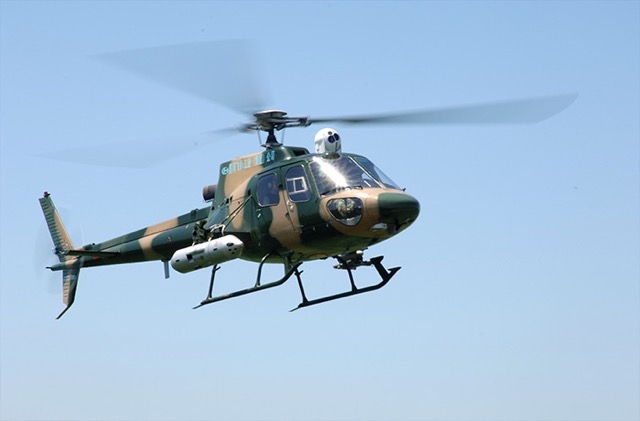Z-11
Summary
| Category | Military Helicopters |
| Origin country | 🇨🇳 China |
| Manufacturer | Changhe |
| First flight | 1 December 1994 |
| Year introduced | 1998 |
| Number produced | 46 units |
Description
The Changhe Z-11 is a light utility helicopter manufactured by Changhe Aircraft Industries Corporation (CAIC) in the People's Republic of China. It is a licensed built version of the French Eurocopter (now Airbus Helicopters) AS350 Écureuil, tailored to meet Chinese requirements. The development of the Z-11 began after an agreement between China and France in the late 1980s, with the first prototype flying in December 1994. The Chinese variant includes modifications and uses some indigenous systems to distinguish it from its Eurocopter counterpart. It serves both military and civilian roles, with applications ranging from general transportation to training, law enforcement, and surveillance missions.
The development of the Changhe Z-11 started as a part of China's efforts to modernize its helicopter fleet and to foster its domestic aerospace industry. Following the agreement with France, Chinese engineers worked to adapt the AS350's design to suit both the operational requirements of the Chinese users and the industrial capabilities of China's aerospace sector.
In its design phase, the Z-11 was altered from the original AS350 to better suit the specific needs of Chinese conditions, such as high-altitude flight performance given China's varied topography, which includes several mountainous regions. It is equipped with a tail rotor and fenestron, which is a characteristic design element of the original Écureuil series, contributing to improved flight control and reduced noise levels.
The Z-11 retains the light single-engine multi-purpose utility concept of the AS350, but it incorporates different avionics and systems that are sourced from Chinese manufacturers. The cockpit was redesigned to accommodate new electronics and instrumentation, and the materials used in the airframe were adapted to available local resources and manufacturing techniques.
Powerplant options for the Z-11 may include different engines than those used by the AS350, tailored to meet the power and efficiency requirements. The airframe was also slightly modified for better performance under the operating conditions encountered in China, such as high altitudes and temperatures.
For military applications, the Z-11WB has been modified to be a light attack helicopter, comparable to the MH-6 Little Bird. These modifications include 2 hardpoints for carrying weapons and other mission-specific gear, enhancing the helicopter's versatility on the field. The shape of the cockpit is also distinctive from other versions, with a round nose.
Armament
The Z-11WB variant can be armed with a multitude of weapons, supporting up to 1 ton of armament load.
The Z-11WB can be fitted with CS/LM12 7.62mm miniguns or LG3 40mm automatic grenade launchers on its doors. The helicopter also has 2 hardpoints along its fuselage for an assortment of weaponry, including air-to-surface missiles such as the TL-2, AG-300, and CM-502KG, in addition to the anti-tank BA-7 and HJ-8 missiles, and the TY-90 for air-to-air combat. For further versatility, it carries guided FT-9 and YZ-212D bombs, unguided rocket pods, and even an SW-6 unmanned aerial vehicle for air-launched operations.
Pylons on the Z-11WB are designed to incorporate a quad launcher for TL-2 missiles, which are laser-guided for precision against various targets, including small vessels and ground forces. The craft is also capable of deploying the AG-300/M missile and the tactical UAV, SW-6.
Operational history
The Changhe Z-11 has a relatively modest operational history compared to more prominent and widely exported helicopters. Since its first flight in 1994, the Z-11 has been primarily operated by Chinese entities, both in civil and military capacities.
In the military sphere, the Z-11 serves the People's Liberation Army (PLA) in various roles, including training, light utility, and reconnaissance. Due to the limited public data on the PLA's internal operations and the fact that China does not extensively publish detailed information about its military equipment's deployment, the specifics of the Z-11’s military service are not widely documented in open-source intelligence.
On the civilian front, the Z-11 has seen more visibility. It's been used for a range of services, such as police work, emergency medical services, transport, and executive travel. The aircraft is suitable for operations in China's diverse environments, from its urban centers to the remote and mountainous regions where its high-altitude performance is beneficial.
Throughout its operational history, the Z-11 has been part of China's broader push to develop a self-reliant aerospace industry, serving as a learning platform for indigenous helicopter production and development. The Z-11 remains a domestic asset. The export of Chinese military equipment has typically focused on other platforms that are either larger or have been specifically designed for export markets.
Variants
- Z-11: This is the basic utility version, adapted from the AS350 and modified for Chinese use, primarily serving in civilian roles such as police work, transport, and training.
- Z-11J: A variant tailored for high-altitude operations, likely equipped with a more powerful engine and other adaptations for performance in mountainous terrain.
- Z-11W: A militarized version designed for the People's Liberation Army, with provisions for weapons and enhanced avionics for combat operations.
- Z-11WB: An advanced version unveiled around 2016, which features upgrades for battlefield reconnaissance, ground attack, cargo transport, and casualty evacuation. It comes with modern avionics and can carry weapon systems like machine guns, grenade launchers, and anti-tank missiles. It’s recognizable to its “round nose” compared to the other versions.
Technical specifications
| Version: Z-11WB | |
|---|---|
| Crew | 1 pilot |
| Maximum speed | 278 km/h (173 mph) |
| Height | 3.1 m (10.3 ft) |
| Max. takeoff weight | 2,200 kg (4,850 lbs) |
| Climb rate | 8.3 m/s (27.2 ft/s) |
| Powerplant | 1 x turboprop Zhuzhou WZ-8D delivering 632 kW each |
Current operating countries
| Country | Units | ||
|---|---|---|---|

|
China | 46 | |
All operators
